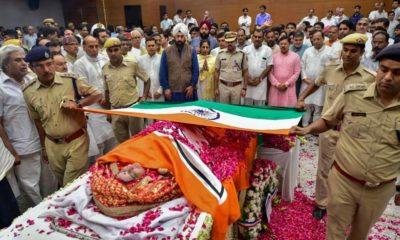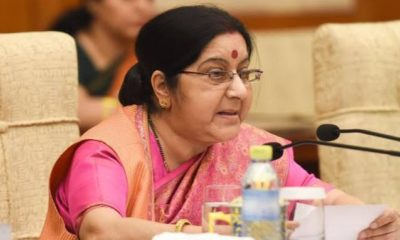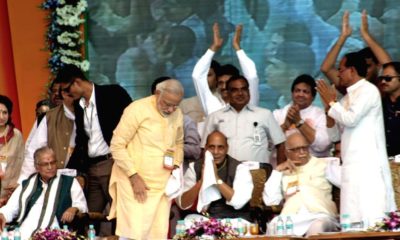Top News
Comatose for nine years, 2006 train blasts victim dies

Mumbai: Nine years after being in coma, Parag Sawant, who was injured in the July 11, 2006 Mumbai suburban train serial blasts, died here early Tuesday, officials said.
Then aged 27, Sawant was travelling in a Churchgate-Virar train to his home when a bomb ripped apart a coach of the suburban local near Bhayander.
He suffered extensive head injuries and brain trauma and was rushed to the Bhaktivedanta Hospital in Mira Road before being shifted to P.D. Hinduja Hospital in south Mumbai.
“I am sad to hear the news. In fact last week, I was discussing with his family members my plans to visit Parag (Sawant) at the hospital on the ninth anniversary of the 7/11 blasts next Saturday. His family and Parag took the tragedy bravely,” said Kirit Somaiya, Mumbai North-East BJP MP.
One of the last survivors of the terror attack, Sawant, 36, is survived by his wife Priti, rehabilitated with a job in Indian Railways, and minor daughter Praniti, eight years old whom he never saw as she was born after he lapsed into a vegetative state.
Sawant had become popular among the masses for his will to live, had regained consciousness briefly in 2008, and was visited by personalities like former deputy prime minister L.K. Advani and union Minister Sushma Swaraj.
The 7/11 Mumbai suburban trains serial blasts, carried out in a span of just 11 minutes, targeted the crowded suburban services during the evening peak hours as bombs kept in pressure cookers went off in north-bound locals on Western Railway.
A total of 209 commuters were killed and another 700-plus injured in the most deadly attack on Mumbai’s lifeline at Bhayander, Borivali, Jogeshwari, Khar Road, Bandra, Mahim and Matunga Road, while one unexploded bomb was found by police and defused at Borivali.
Entertainment
Casino Days Reveal Internal Data on Most Popular Smartphones

International online casino Casino Days has published a report sharing their internal data on what types and brands of devices are used to play on the platform by users from the South Asian region.
Such aggregate data analyses allow the operator to optimise their website for the brands and models of devices people are actually using.
The insights gained through the research also help Casino Days tailor their services based on the better understanding of their clients and their needs.
Desktops and Tablets Lose the Battle vs Mobile
The primary data samples analysed by Casino Days reveal that mobile connections dominate the market in South Asia and are responsible for a whopping 96.6% of gaming sessions, while computers and tablets have negligible shares of 2.9% and 0.5% respectively.
The authors of the study point out that historically, playing online casino was exclusively done on computers, and attribute thе major shift to mobile that has unfolded over time to the wide spread of cheaper smartphones and mobile data plans in South Asia.
“Some of the reasons behind this massive difference in device type are affordability, technical advantages, as well as cheaper and more obtainable internet plans for mobiles than those for computers,” the researchers comment.
Xiaomi and Vivo Outperform Samsung, Apple Way Down in Rankings
Chinese brands Xiaomi and Vivo were used by 21.9% and 20.79% of Casino Days players from South Asia respectively, and together with the positioned in third place with a 18.1% share South Korean brand Samsung dominate the market among real money gamers in the region.
Cupertino, California-based Apple is way down in seventh with a user share of just 2.29%, overshadowed by Chinese brands Realme (11.43%), OPPO (11.23%), and OnePlus (4.07%).
Huawei is at the very bottom of the chart with a tiny share just below the single percent mark, trailing behind mobile devices by Motorola, Google, and Infinix.
The data on actual phone usage provided by Casino Days, even though limited to the gaming parts of the population of South Asia, paints a different picture from global statistics on smartphone shipments by vendors.
Apple and Samsung have been sharing the worldwide lead for over a decade, while current regional leader Xiaomi secured their third position globally just a couple of years ago.
Striking Android Dominance among South Asian Real Money Gaming Communities
The shifted market share patterns of the world’s top smartphone brands in South Asia observed by the Casino Days research paper reveal a striking dominance of Android devices at the expense of iOS-powered phones.
On the global level, Android enjoys a comfortable lead with a sizable 68.79% share which grows to nearly 79% when we look at the whole continent of Asia. The data on South Asian real money gaming communities suggests that Android’s dominance grows even higher and is north of the 90% mark.
Among the major factors behind these figures, the authors of the study point to the relative affordability of and greater availability of Android devices in the region, especially when manufactured locally in countries like India and Vietnam.
“And, with influencers and tech reviews putting emphasis on Android devices, the choice of mobile phone brand and OS becomes easy; Android has a much wider range of products and caters to the Asian online casino market in ways that Apple can’t due to technical limitations,” the researchers add.
The far better integration achieved by Google Pay compared to its counterpart Apple Pay has also played a crucial role in shaping the existing smartphone market trends.
Content provided by Adverloom

























